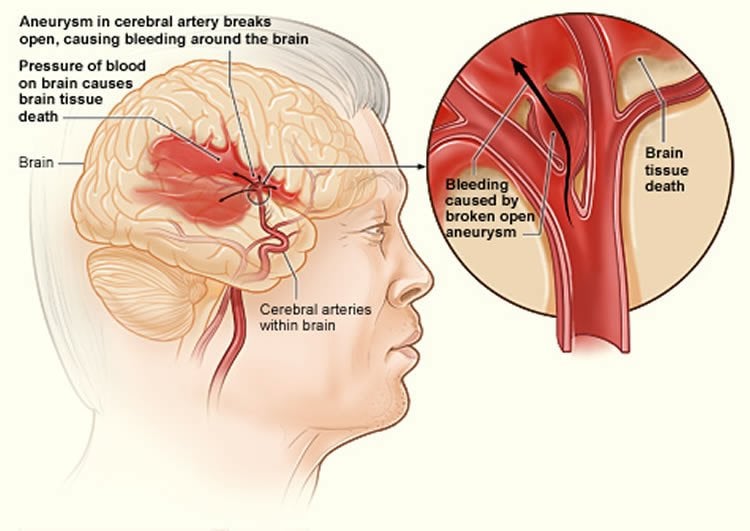Summary: According to researchers, air pollution has become one of the leading global risk factors for stroke.
Source: The Lancet.
Air pollution, including environmental and household air pollution, has emerged as a leading risk factor for stroke worldwide, associated with about a third of the global burden of stroke in 2013, according to a new study published in The Lancet Neurology journal.
The findings, from an analysis of global trends of risk factors for stroke between 1990-2013, also show that over 90% of the global burden of stroke is linked to modifiable risk factors, most of which (74%) are behavioural risk factors such as smoking, poor diet and low physical activity. The authors estimate that control of these risk factors could prevent about three-quarters of all strokes.
The study is the first to analyse the global risk factors for stroke in such detail, especially in relation to stroke burden on global, regional and national levels. The researchers used data from the Global Burden of Disease Study to estimate the disease burden of stroke associated with 17 risk factors in 188 countries. They estimated the population-attributable fraction (PAF) of stroke-related disability-adjusted life years (DALYs) — ie. the estimated proportion of disease burden in a population that would be avoided if exposure to a risk factor were eliminated.
Every year, approximately 15 million people worldwide suffer a stroke — of these, nearly six million die and five million are left with permanent disability. Disability may include loss of vision and/or speech, paralysis and confusion.
Globally, the ten leading risk factors for stroke were high blood pressure, diet low in fruit, high body mass index (BMI), diet high in sodium, smoking, diet low in vegetables, environmental air pollution, household pollution from solid fuels, diet low in whole grains, and high blood sugar. About a third (29.2%) of global disability associated with stroke is linked to air pollution (including environmental air pollution and household air pollution). This is especially high in developing countries (33.7% vs 10.2% in developed countries).
In 2013, 16.9% of the global stroke burden was attributed to environmental air pollution (as measured by ambient particle matter [PM] pollution of aerodynamic diameter smaller than 2·5 μm) — almost as much as that from smoking (20.7%) (paper, table). From 1990 to 2013, stroke burden associated with environmental air pollution (PM25) has increased by over 33%.
“A striking finding of our study is the unexpectedly high proportion of stroke burden attributable to environmental air pollution, especially in developing countries. Smoking, poor diet and low physical activity are some of the major risk factors for stroke worldwide, suggesting that stroke is largely a disease caused by lifestyle risk factors. Controlling these risk factors could prevent about three-quarters of strokes worldwide.” says lead author Professor Valery L Feigin, of Auckland University of Technology, New Zealand.
“Our findings are important for helping national governments and international agencies to develop and prioritise public health programmes and policies. Governments have the power and responsibility to influence these risk factors through legislation and taxation of tobacco, alcohol, salt, sugar or saturated fat content, while health service providers have the responsibility to check and treat risk factors such as high blood pressure,” he says.
“Taxation has been proven to be the most effective strategy in reducing exposure to smoking and excessive intake of salt, sugar and alcohol. If these risks take a toll on our health, and taxation is the best way to reduce exposure to these risks, it logically follows that governments should introduce such taxation and reinvest the resulting revenue back into the health of the population by funding much needed preventative programmes and research in primary prevention and health. All it takes is recognition of the urgent need to improve primary prevention, and the good will of the governments to act,” says Professor Feigin.
The relative importance of risk factors varied depending on age group, country and region:
- Household air pollution was a more important risk factor for stroke in central, eastern, and western sub-Saharan Africa and south Asia (ranked 3rd), compared to North America, central, eastern and western Europe (where it was not in the top 10 risk factors)
- Low physical activity was a much greater risk factor for stroke among adults over 70 than among adults aged 15-69.
- Globally, the risk factor that was most reduced between 1990 and 2013 was second-hand smoke (31% reduction in stroke-related DALYs).
- The greatest reduction was in developed countries, but the contribution of second-hand smoke to global stroke burden still remains noticeable at 3.1% for 15-49 year olds, especially in developing countries where it reaches 3.2%.
- The risk factor that was most increased was a diet high in sugar-sweetened beverages (63.1% increase in stroke-related DALYs).
- The greatest increase was in developed countries but the contribution to stroke burden remains low at 1.6% for 15-49 year olds.
- Air pollution, environmental risks, tobacco smoke, high blood pressure and dietary risks were more important risk factors for stroke in developing countries compared to developed countries.
- Low physical activity was a more important risk factor for stroke in developed countries compared to developing countries.
The authors say that because of a lack of data, they could not include some important risk factors for stroke such as atrial fibrillation, substance abuse or other health conditions. They were also unable to account for patterns of some risk factors such as levels of smoking, BMI level or underlying genetic risk factors. The data does not differentiate between ischaemic and haemorrhagic strokes but the authors say that while the risk factors for different types of stroke may vary slightly at the individual level, global, regional and national policies tend to look at the overall risk of stroke.
The study also provides information on the contribution of all 17 risk factors for stroke for 188 countries, for example the top 5 risk factors for stroke in the following countries were:
- UK & USA: high blood pressure, high BMI, diet low in fruit, diet low in vegetables, smoking.
- India: high blood pressure, diet low in fruit, household air pollution, diet low in vegetables, diet high in sodium.
- China: high blood pressure, diet low in fruit, diet high in sodium, smoking, environmental air pollution.

Writing in a linked Comment, Professor Vladimir Hachinski, University of Western Ontario, London, Canada and Dr Mahmoud Reza Azarpazhooh, Mashhad University of Medical Sciences, Mashhad, Iran, say: “The most alarming finding was that about a third of the burden of stroke is attributable to air pollution. Although air pollution is known to damage the lungs, heart, and brain, the extent of this threat seems to have been underestimated. Air pollution is not just a problem in big cities, but is also a global problem. With the ceaseless air streams across oceans and continents, what happens in Beijing matters in Berlin. Air pollution is one aspect of the fossil fuel and global warming problem, which is itself partly a result of westernisation and urbanisation, especially in India and China. In 1900, only about 15% of the world’s population lived in cities; now more than half the world’s population does. In cities, particularly in megacities (>10 million inhabitants), getting unhealthy food is easy and getting exercise is hard, emphasising the difficulty of achieving a healthy lifestyle in an unhealthy environment.”
Funding: This study was funded by the Bill & Melinda Gates Foundation, American Heart Association, US National Heart, Lung, and Blood Institute, Columbia University, Health Research Council of New Zealand, Brain Research New Zealand Centre of Research Excellence, and National Science Challenge, Ministry of Business, Innovation and Employment of New Zealand.
Source: Professor Valery L Feigin – The Lancet
Image Source: This NeuroscienceNews.com image is in the public domain.
Original Research: Abstract for “Global burden of stroke and risk factors in 188 countries, during 1990–2013: a systematic analysis for the Global Burden of Disease Study 2013” by Prof Valery L Feigin, MD, Gregory A Roth, MD, Prof Mohsen Naghavi, MD, Priya Parmar, PhD, Rita Krishnamurthi, PhD, Sumeet Chugh, MD, George A Mensah, MD, Prof Bo Norrving, MD, Ivy Shiue, PhD, Marie Ng, PhD, Kara Estep, BA, Kelly Cercy, BA, Prof Christopher J L Murray, MD, Prof Mohammad H Forouzanfar, PhD for the Global Burden of Diseases, Injuries and Risk Factors Study 2013 and Stroke Experts Writing Group in The Lancet Neurology. Published online June 2016 doi:10.1016/S1474-4422(16)30073-4
[cbtabs][cbtab title=”MLA”]The Lancet. “Air Pollution Emerges as a Leading Risk Factor for Stroke Worldwide .” NeuroscienceNews. NeuroscienceNews, 12 June 2016.
<https://neurosciencenews.com/stroke-air-pollution-4445/>.[/cbtab][cbtab title=”APA”]The Lancet. (2016, June 12). Air Pollution Emerges as a Leading Risk Factor for Stroke Worldwide . NeuroscienceNews. Retrieved June 12, 2016 from https://neurosciencenews.com/stroke-air-pollution-4445/[/cbtab][cbtab title=”Chicago”]The Lancet. “Air Pollution Emerges as a Leading Risk Factor for Stroke Worldwide .” https://neurosciencenews.com/stroke-air-pollution-4445/ (accessed June 12, 2016).[/cbtab][/cbtabs]
Abstract
Global burden of stroke and risk factors in 188 countries, during 1990–2013: a systematic analysis for the Global Burden of Disease Study 2013
Background
The contribution of modifiable risk factors to the increasing global and regional burden of stroke is unclear, but knowledge about this contribution is crucial for informing stroke prevention strategies. We used data from the Global Burden of Disease Study 2013 (GBD 2013) to estimate the population-attributable fraction (PAF) of stroke-related disability-adjusted life-years (DALYs) associated with potentially modifiable environmental, occupational, behavioural, physiological, and metabolic risk factors in different age and sex groups worldwide and in high-income countries and low-income and middle-income countries, from 1990 to 2013.
Methods
We used data on stroke-related DALYs, risk factors, and PAF from the GBD 2013 Study to estimate the burden of stroke by age and sex (with corresponding 95% uncertainty intervals [UI]) in 188 countries, as measured with stroke-related DALYs in 1990 and 2013. We evaluated attributable DALYs for 17 risk factors (air pollution and environmental, dietary, physical activity, tobacco smoke, and physiological) and six clusters of risk factors by use of three inputs: risk factor exposure, relative risks, and the theoretical minimum risk exposure level. For most risk factors, we synthesised data for exposure with a Bayesian meta-regression method (DisMod-MR) or spatial-temporal Gaussian process regression. We based relative risks on meta-regressions of published cohort and intervention studies. Attributable burden for clusters of risks and all risks combined took into account evidence on the mediation of some risks, such as high body-mass index (BMI), through other risks, such as high systolic blood pressure (SBP) and high total cholesterol.
Findings
Globally, 90·5% (95% UI 88·5–92·2) of the stroke burden (as measured in DALYs) was attributable to the modifiable risk factors analysed, including 74·2% (95% UI 70·7–76·7) due to behavioural factors (smoking, poor diet, and low physical activity). Clusters of metabolic factors (high SBP, high BMI, high fasting plasma glucose, high total cholesterol, and low glomerular filtration rate; 72·4%, 95% UI 70·2–73·5) and environmental factors (air pollution and lead exposure; 33·4%, 95% UI 32·4–34·3) were the second and third largest contributors to DALYs. Globally, 29·2% (95% UI 28·2–29·6) of the burden of stroke was attributed to air pollution. Although globally there were no significant differences between sexes in the proportion of stroke burden due to behavioural, environmental, and metabolic risk clusters, in the low-income and middle-income countries, the PAF of behavioural risk clusters in males was greater than in females. The PAF of all risk factors increased from 1990 to 2013 (except for second-hand smoking and household air pollution from solid fuels) and varied significantly between countries.
Interpretation
Our results suggest that more than 90% of the stroke burden is attributable to modifiable risk factors, and achieving control of behavioural and metabolic risk factors could avert more than three-quarters of the global stroke burden. Air pollution has emerged as a significant contributor to global stroke burden, especially in low-income and middle-income countries, and therefore reducing exposure to air pollution should be one of the main priorities to reduce stroke burden in these countries.
Funding
Bill & Melinda Gates Foundation, American Heart Association, US National Heart, Lung, and Blood Institute, Columbia University, Health Research Council of New Zealand, Brain Research New Zealand Centre of Research Excellence, and National Science Challenge, Ministry of Business, Innovation and Employment of New Zealand.
“Global burden of stroke and risk factors in 188 countries, during 1990–2013: a systematic analysis for the Global Burden of Disease Study 2013” by Prof Valery L Feigin, MD, Gregory A Roth, MD, Prof Mohsen Naghavi, MD, Priya Parmar, PhD, Rita Krishnamurthi, PhD, Sumeet Chugh, MD, George A Mensah, MD, Prof Bo Norrving, MD, Ivy Shiue, PhD, Marie Ng, PhD, Kara Estep, BA, Kelly Cercy, BA, Prof Christopher J L Murray, MD, Prof Mohammad H Forouzanfar, PhD for the Global Burden of Diseases, Injuries and Risk Factors Study 2013 and Stroke Experts Writing Group in The Lancet Neurology. Published online June 2016 doi:10.1016/S1474-4422(16)30073-4






